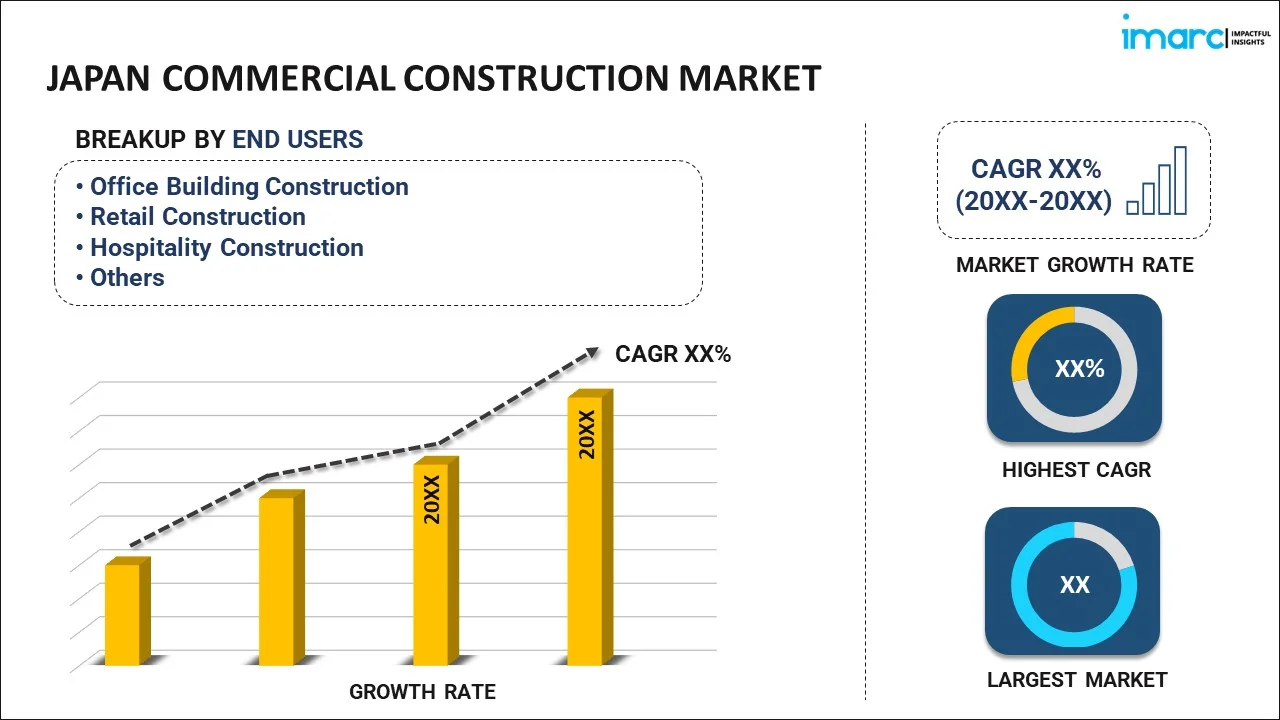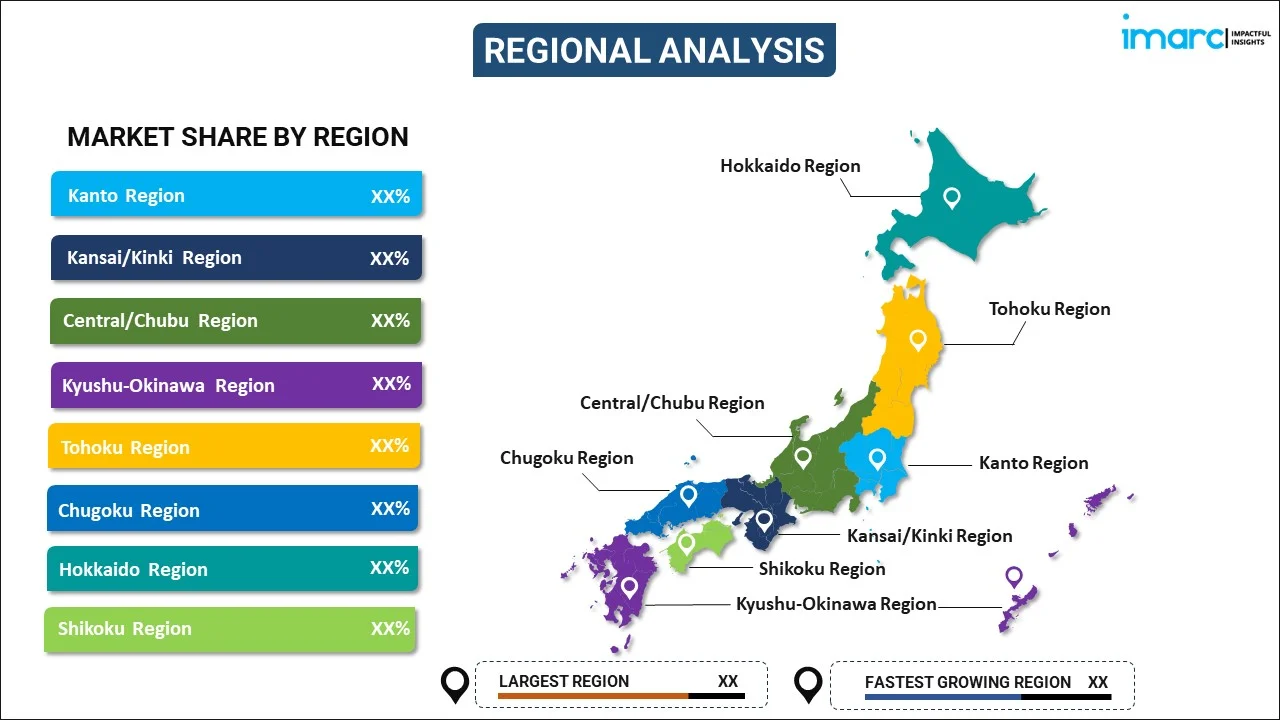
Japan Commercial Construction Market Report by End User (Office Building Construction, Retail Construction, Hospitality Construction, Institutional Construction, and Others), and Region 2025-2033
Market Overview:
Japan commercial construction market size reached USD 216.3 Billion in 2024. Looking forward, IMARC Group expects the market to reach USD 310.5 Billion by 2033, exhibiting a growth rate (CAGR) of 3.7% during 2025-2033. The increasing advancements in construction technology, such as building information modeling (BIM), 3D printing, and automation, that can enhance efficiency, reduce costs, and attract more projects is driving the market.
|
Report Attribute
|
Key Statistics
|
|---|---|
|
Base Year
|
2024
|
|
Forecast Years
|
2025-2033
|
|
Historical Years
|
2019-2024
|
|
Market Size in 2024
|
USD 216.3 Billion |
|
Market Forecast in 2033
|
USD 310.5 Billion |
| Market Growth Rate 2025-2033 | 3.7% |
Commercial construction refers to the process of designing, planning, and erecting buildings and structures intended for business purposes rather than residential or industrial use. It encompasses a wide range of projects, from office buildings and retail spaces to hotels, restaurants, and warehouses. Commercial construction typically involves several key phases, including project conception, architectural and engineering design, obtaining permits, site preparation, construction, and interior fit-out. Skilled professionals, such as project managers, architects, engineers, and skilled tradespeople, collaborate to bring these projects to fruition. Key considerations in commercial construction include functionality, aesthetics, safety, and compliance with local building regulations and codes. Projects may vary in scale and complexity, with some involving ground-up construction and others focusing on renovation or expansion of existing structures. Commercial construction plays a vital role in supporting economic growth by providing spaces for businesses to operate, which, in turn, create jobs and stimulate local economies.
Japan Commercial Construction Market Trends:
The commercial construction market in Japan is expanding due to urbanization; as more people migrate to urban areas in search of employment and enhanced living standards, there is an increased demand for commercial spaces like retail stores, offices, and entertainment venues. Moreover, economic stability plays a crucial role. In periods of economic growth, businesses expand, leading to a surge in need for commercial real estate, thus driving regional construction projects. Additionally, advancements in technology have altered the way commercial spaces are designed and utilized. The integration of smart technologies and sustainable building practices has become a key driver as businesses seek energy-efficient and technologically advanced facilities. Furthermore, government regulations and incentives, particularly those promoting environmental sustainability, influence the commercial construction market in Japan. Tax incentives and stricter environmental standards encourage developers to invest in eco-friendly construction methods and materials. Apart from this, the increasing demand for flexible, adaptable spaces to accommodate remote work trends and health-related requirements is expected to drive the commercial construction market in Japan.
Japan Commercial Construction Market Segmentation:
IMARC Group provides an analysis of the key trends in each segment of the market, along with forecasts at the country level for 2025-2033. Our report has categorized the market based on end user.
End User Insights:

- Office Building Construction
- Retail Construction
- Hospitality Construction
- Institutional Construction
- Others
The report has provided a detailed breakup and analysis of the market based on the end user. This includes office building construction, retail construction, hospitality construction, institutional construction, and others.
Regional Insights:

- Kanto Region
- Kansai/Kinki Region
- Central/ Chubu Region
- Kyushu-Okinawa Region
- Tohoku Region
- Chugoku Region
- Hokkaido Region
- Shikoku Region
The report has also provided a comprehensive analysis of all the major regional markets, which include Kanto Region, Kansai/Kinki Region, Central/ Chubu Region, Kyushu-Okinawa Region, Tohoku Region, Chugoku Region, Hokkaido Region, and Shikoku Region.
Competitive Landscape:
The market research report has also provided a comprehensive analysis of the competitive landscape. Competitive analysis such as market structure, key player positioning, top winning strategies, competitive dashboard, and company evaluation quadrant has been covered in the report. Also, detailed profiles of all major companies have been provided.
Japan Commercial Construction Market Report Coverage:
| Report Features | Details |
|---|---|
| Base Year of the Analysis | 2024 |
| Historical Period | 2019-2024 |
| Forecast Period | 2025-2033 |
| Units | Billion USD |
| Scope of the Report | Exploration of Historical and Forecast Trends, Industry Catalysts and Challenges, Segment-Wise Historical and Predictive Market Assessment:
|
| End Users Covered | Office Building Construction, Retail Construction, Hospitality Construction, Institutional Construction, Others |
| Regions Covered | Kanto Region, Kansai/Kinki Region, Central/ Chubu Region, Kyushu-Okinawa Region, Tohoku Region, Chugoku Region, Hokkaido Region, Shikoku Region |
| Customization Scope | 10% Free Customization |
| Post-Sale Analyst Support | 10-12 Weeks |
| Delivery Format | PDF and Excel through Email (We can also provide the editable version of the report in PPT/Word format on special request) |
Key Questions Answered in This Report:
- How has the Japan commercial construction market performed so far and how will it perform in the coming years?
- What has been the impact of COVID-19 on the Japan commercial construction market?
- What is the breakup of the Japan commercial construction market on the basis of end user?
- What are the various stages in the value chain of the Japan commercial construction market?
- What are the key driving factors and challenges in the Japan commercial construction?
- What is the structure of the Japan commercial construction market and who are the key players?
- What is the degree of competition in the Japan commercial construction market?
Key Benefits for Stakeholders:
- IMARC’s industry report offers a comprehensive quantitative analysis of various market segments, historical and current market trends, market forecasts, and dynamics of the Japan commercial construction market from 2019-2033.
- The research report provides the latest information on the market drivers, challenges, and opportunities in the Japan commercial construction market.
- Porter's five forces analysis assist stakeholders in assessing the impact of new entrants, competitive rivalry, supplier power, buyer power, and the threat of substitution. It helps stakeholders to analyze the level of competition within the Japan commercial construction industry and its attractiveness.
- Competitive landscape allows stakeholders to understand their competitive environment and provides an insight into the current positions of key players in the market.
Need more help?
- Speak to our experienced analysts for insights on the current market scenarios.
- Include additional segments and countries to customize the report as per your requirement.
- Gain an unparalleled competitive advantage in your domain by understanding how to utilize the report and positively impacting your operations and revenue.
- For further assistance, please connect with our analysts.
 Inquire Before Buying
Inquire Before Buying
 Speak to an Analyst
Speak to an Analyst
 Request Brochure
Request Brochure
 Request Customization
Request Customization




.webp)




.webp)












